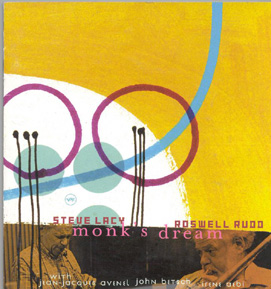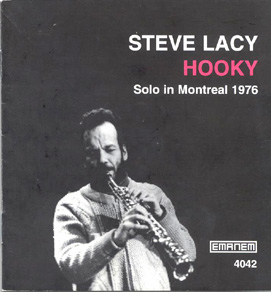Monk’s Dream: Verve 543 090-2
Hooky, Solo in Montreal 1976: Emanem 4042
©Laurence Svirchev
 It’s about time that Steve Lacy, that percipient nous of modern music, scored on a major label like Verve. He has been universally recognized among his musician peers for decades as one of the most articulate players of the soprano saxophone. He is also a prolific composer who inevitably dedicates his compositions to artists who have inspired him. He is one of a handful of jazz musicians adept in that most difficult form, the art song. And if this is not enough, Lacy belongs to that rarefied class of musicians –along with trombonist Roswell Rudd- who can interpret the music of Thelonious Monk with authority.
It’s about time that Steve Lacy, that percipient nous of modern music, scored on a major label like Verve. He has been universally recognized among his musician peers for decades as one of the most articulate players of the soprano saxophone. He is also a prolific composer who inevitably dedicates his compositions to artists who have inspired him. He is one of a handful of jazz musicians adept in that most difficult form, the art song. And if this is not enough, Lacy belongs to that rarefied class of musicians –along with trombonist Roswell Rudd- who can interpret the music of Thelonious Monk with authority.
These two CDs substantiate the above-mentioned qualities. A special treat is that on the Verve CD he is reunited with his “school days” buddy, Roswell Rudd. On each composition, be it a Monk, an Ellington, or a Lacy, the two masters glide with aplomb through the melodic structures and swing the counterpoints like Ginger Rodgers-Fred Astaire dancing. Lacy, known for his meticulous articulation, seems elegantly loose with Rudd as his confrere. On “The Bath” (a song about pleasure, dedicated to Dexter Gordon), listen to Rudd’s wah-wah-wah at 4:34 and you can feel the human body sensuously slide into a tub of hot water, maybe even a bubble-bath.
 Throughout his career, Lacy’s intellect and sentience have taken him to ancient sources of wisdom. On “Traces” he sets music to a poem by the Zen monk Ry_kan. Irene Aebi, in her unique operatic dialect, sings the words beatifically to Lacy’s precise melody. This art song format is one of the distinguishing features of Lacy’s music.
Throughout his career, Lacy’s intellect and sentience have taken him to ancient sources of wisdom. On “Traces” he sets music to a poem by the Zen monk Ry_kan. Irene Aebi, in her unique operatic dialect, sings the words beatifically to Lacy’s precise melody. This art song format is one of the distinguishing features of Lacy’s music.
“Hooky” is a solo soprano saxophone recital recorded in a church. The music ranges in content from the tile track (with Lacy pronouncing “don’t go to school” before he launches into the melody) to a cycle of six songs inspired by the Tao of Lao-Tzu. The Tao cycle opens with a complex structure dedicated to John Coltrane. It ends with Lacy wandering through the church exploring its sound qualities while he plays a repeating riff dedicated to Duke Ellington, “Life On Its Way.”